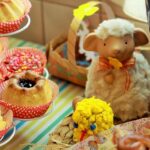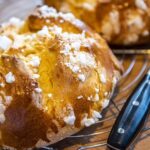
Easter in Germany is full of beautiful traditions, and one of the most beloved is baking an Osterlamm, the German Easter lamb cake. This light and fluffy sponge cake, baked in a lamb-shaped mold, is a symbol of peace, innocence, and the resurrection of Christ. Decorated with powdered sugar, a red ribbon, or chocolate glaze, Osterlamm is a beautiful addition to any Easter table.
Baking an Easter lamb cake is a tradition in many German families, passed down through generations. The cake is often the centerpiece of Easter brunch and is served alongside other festive treats like Osterzopf (braided Easter bread) and Hefezopf (sweet yeast braid).
In this guide, we’ll explore the history of Osterlamm, its cultural significance, and provide a step-by-step recipe so you can bake this classic Easter cake at home.
History & Cultural Significance
The Origins of Osterlamm
The symbolism of the lamb has deep religious and cultural significance. In Christianity, the lamb represents Jesus Christ, the “Lamb of God,” and is a symbol of purity, renewal, and sacrifice. For centuries, Germans have baked Osterlamm cakes as part of their Easter celebrations, placing them at the center of their festive tables.
Traditionally, the cake is made with a light sponge or pound cake batter, and it is baked in a special lamb-shaped mold (Osterlamm-Form). Once baked, it is dusted with powdered sugar or covered in chocolate glaze. Some families decorate it with a red ribbon to symbolize victory over death, while others serve it with fresh berries or Easter eggs.
Osterlamm is especially popular in southern Germany, Austria, and Switzerland, where it has been a part of Easter traditions for generations.
Want to explore more German Easter recipes? Check out our articles on Osterkranz and Easter Bunny Cake.
Ingredients & Preparation (Step-by-Step Recipe Guide)
Ingredients for Authentic Osterlamm
Cake Ingredients:
- 120g (1 cup) all-purpose flour
- 100g (½ cup) sugar
- 2 eggs
- 100g (½ cup) unsalted butter, softened
- 1 tsp baking powder
- 1 tsp vanilla extract
- 50ml (¼ cup) milk
- Zest of 1 lemon (optional)
- Pinch of salt
For Decoration:
- Powdered sugar (for dusting)
- Melted chocolate (optional, for glazing)
- Red ribbon (for traditional decoration)
Substitutes: For a richer flavor, use almond or hazelnut flour instead of regular flour. For a citrus twist, add orange zest instead of lemon zest.
How to Make Osterlamm (Step-by-Step Instructions)
Step 1: Prepare the Mold and Preheat the Oven
- Preheat your oven to 175°C (350°F).
- Grease and flour a lamb-shaped cake mold (Osterlamm-Form) to prevent sticking.
Step 2: Make the Batter
- In a mixing bowl, cream the butter and sugar until light and fluffy.
- Add the eggs one at a time, beating well after each addition.
- Stir in vanilla extract and lemon zest.
- In a separate bowl, mix the flour, baking powder, and salt.
- Gradually add the dry ingredients to the wet ingredients, alternating with the milk, and mix until smooth.
Pro Tip: Do not overmix the batter, as this can make the cake dense instead of fluffy.
Step 3: Fill the Mold and Bake
- Pour the batter into the prepared lamb mold, spreading evenly.
- Tap the mold gently on the counter to remove air bubbles.
- Bake for 35-40 minutes, or until a toothpick inserted in the center comes out clean.
Step 4: Cool and Decorate
- Let the cake cool in the mold for 10 minutes before carefully removing it.
- Dust the lamb with powdered sugar for a classic look or drizzle with melted chocolate for extra richness.
- Tie a red ribbon around the lamb’s neck for a festive touch.
Serving Suggestions & Variations
How to Serve Osterlamm
Osterlamm is best served as part of an Easter breakfast or brunch alongside:
- Fresh berries and whipped cream
- A cup of coffee or hot chocolate
- Easter eggs and festive decorations
Variations & Regional Twists
In Bavaria, some Osterlamm cakes are made with ground almonds for extra moisture. In Austria, the cake is often brushed with apricot jam before being dusted with powdered sugar. In Switzerland, Osterlamm is sometimes flavored with cinnamon and nutmeg for a spiced version.
Want to try another Easter treat? Check out our Hefezopf (Sweet Yeast Braid)] recipe.
Baking Osterlamm at home is a meaningful and delicious way to celebrate Easter. Its light, fluffy texture and beautiful presentation make it a special part of any holiday table. Whether you enjoy it plain, dusted with powdered sugar, or covered in chocolate glaze, this Easter lamb cake is a cherished German tradition.
Looking for more traditional German Easter recipes? Explore our recipes for Osterzopf, Rüblikuchen, and Franzbrötchen.







